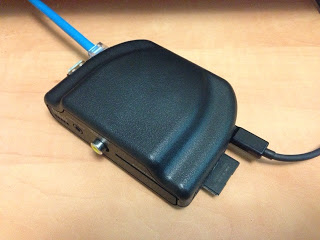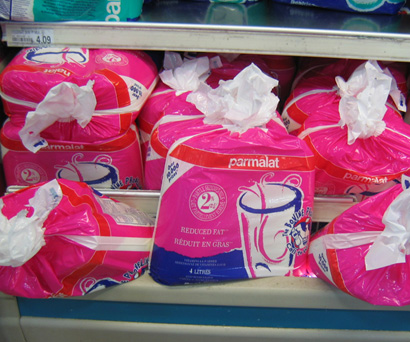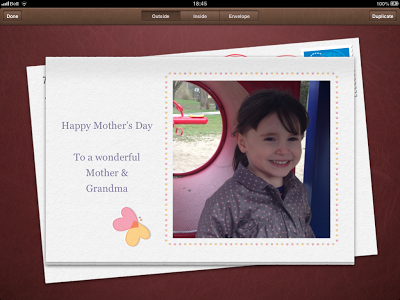-
A cool slice of Raspberry Pi

It may not look like much, but this little gizmo is actually now powering my entire home phone system, courtesy of Freeswitch and VoiP.ms.
The device in question is a Raspberry Pi — a small, $35 ARM-based GNU/Linux box, essentially a credit-card sized computer. I ordered one last week, partly with the interest in turning it into a phone server, but mostly just to play around with. The unit itself is about as basic as it comes — 512MB of RAM, an SD card slot, two USB ports, composite video + HDMI output, and a single Ethernet jack — but it's actually more capable than one would expect for $35. No internal storage is provided — you basically supply your own SD card — and it's powered over a micro-USB connection using a 5V adapter. By the time the dust settled, the whole package ran me about $75, including shipping, for which I received the unit itself, a case, power adapter, and small micro-USB cable (I probably could have supplied my own power adapter, but the voltage requirements are very precise, so for the extra $10 I opted to go for the one sold with the unit, just to be safe).
-
Milk in Bags?

Photo credit: The Canadian Design Resource
Yup. Here in this part of Canada we have been buying our milk in large plastic bags since the early 80s. It either never occurred to me or I’d simply forgotten that this is something unique up here, and many of my friends south of the border have probably never seen such a thing.
While traditional cardboard cartons are still used for the 250ml/500ml/1L/2L sizes, if your family drinks a reasonable amount of milk (and who doesn’t if you have kids?) the 4L size is definitely the most economical. You’ll pay around $5.50-$6 for a 4L sack that contains three individual 1.33L bags, as compared to around $4.50-$5 for a 2L cardboard carton.
-
Physical Cards, eCards, and Apple Cards

Jesse Wojdylo asked an interesting question on Google+ this morning that I really hadn’t given much thought to previously: How do people prefer to send out Mother’s Day cards?
While the usual question centers around physical cards vs eCards, I actually realized that I’ve been getting the best of both worlds ever since Apple came out with its “Cards” app for iOS a couple of years ago.
As a technology person, physical cards have not only always seemed a bit “low-tech” for me, but also require me to actually do things in the real world such as going to a store and buying one, and then finding a postage stamp and actually getting it into a mailbox. For somebody who rarely has to deal with sending out physical mail, this is actually a more complicated process than it sounds – there have been times in the past that a card has actually sat on my desk for a week simply waiting for me to go to the post office to buy a stamp.
-
So, what is the point of Google Glass again?
Jolie O’Dell, VentureBeat:

In my moral universe, Google Glass for consumers can only serve to distract us, not truly help us any more, better, or faster than the other tools we already use. For example, you already have Google Maps to guide you around your city with turn-by-turn audio navigation. That tool doesn’t get any better when it’s smack-dab against your eyeball. Neither does your email or your Instagram feed or your Facebook account.
While Jolie O’Dell’s full article is definitely worth a read as one of the first interesting counterpoints to all of the hype around Google Glass, I felt this one quote was a particularly good point that many in the tech blogosphere have missed in their effort to sing the praises of Google Glass and dream up real-world consumer uses for it. While the potential for practical professional uses are myriad, as a consumer product Google Glass seems like the proverbial solution in desperate search of solving some real-world problem that average people are actually having.
-
Switching to Blogger, courtesy of the Google+ Halo Effect

So I’ve decided to switch over to Blogger, driven mostly by the “halo” effect of Google+.
Let me start by being perfectly frank: I don’t do much “blogging” per se. My day job writing for iLounge keeps me pretty busy on that side, not to mention the trials and tribulations of being a stay-at-home dad in the midst of it all. In addition, when I feel I might have something particularly interesting to say, I generally simply turn to Google+ and post it directly there.
Despite this, however, for some reason I’ve always still felt the need to have a blog. Maybe it’s just because that’s what the cool kids are all doing, or maybe it’s just that it’s more of my own personal space to write my musings in the off chance that anybody ever wants to read them. To be fair, my blog also pre-dates the modern evolution of social media, so there’s been an impetus to keep it alive for legacy reasons.